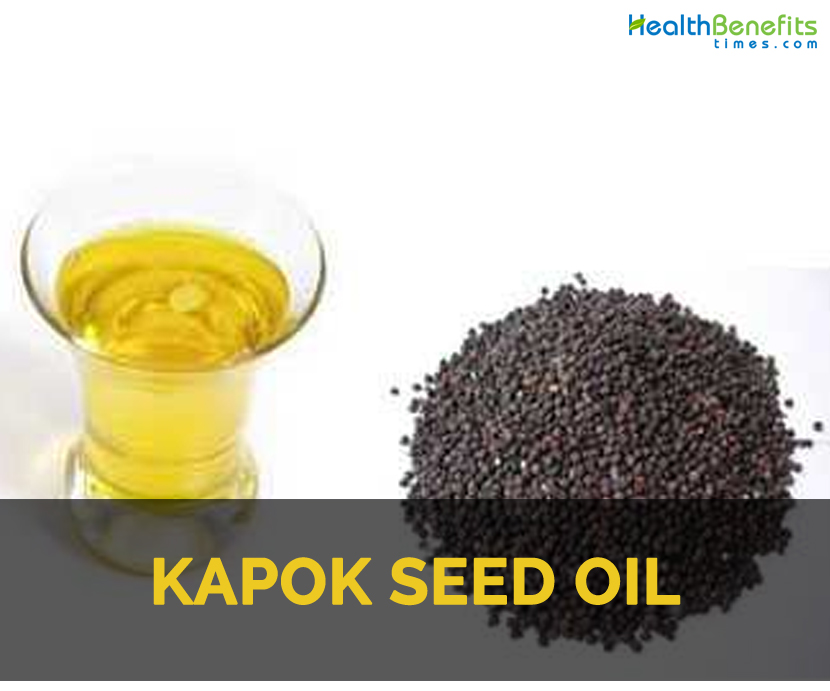Kapok with its scientific name as Ceiba pentandra belongs to the family Malvaceae and order Malvales. It is inherent to Central America, Northern South America and Caribbean as well as Tropical West Africa. The common names for Kapok are Java kapok, Java cotton, Ceiba, Samauma and Silk cotton. Kapok seed oil is a vegetable oil that is extracted from kapok seeds by pressing. The seeds are black having the shape of capsule. The color of the oil is yellow and has mild as well as pleasant taste as well as odor. When exposed to air, it becomes rancid quickly. This oil is produced in Malaysia, Indonesia and India. The iodine value in Kapok oil is from 85-100. It is nondrying oil that does not dry considerably when exposed to air. It is also used in preparing pains or as a biofuel.
Uses
- The oil is applied to the affected areas to provide relief from rheumatism and also heals wounds.
- It could be used to manufacture pains, soaps and also to be used as a biofuel.
Precautions
- The seed oil should not be used until the cyclopropenoid acids are removed.
- Consult a doctor for use.
- Use it in moderate amounts.
Kapok seed oil facts
| Kapok seed oil uses Quick Facts | |
|---|---|
| Name: | Kapok seed oil uses |
| Scientific Name: | Ceiba Pentandra |
| Origin | It is native to Central America, Mexico, Northern South America and Caribbean. It is produced in Malaysia, Indonesia and India. |
| Colors | Yellowish |
| Health benefits | Relieve rheumatism, Cure wounds |
| Name | Kapok seed oil uses |
|---|---|
| Scientific Name of Kapok | Ceiba Pentandra |
| Native | It is native to Central America, Mexico, Northern South America and Caribbean. It is produced in Malaysia, Indonesia and India. |
| Common/English Name of Kapok | Kapok oil, Java cotton, Silk cotton, Java kapok, Ceiba, Samauma, Cotton silk tree, Cotton tree, Devil’s tree, Jumbie tree, White cotton tree |
| Name in Other Languages of Kapok | Spanish: Aceite de kapok; French: Huile de kapok; Spanish: Ceiba; Haitian Creole: Mapou; Portuguese (Brazilian): Sumauma; Surinamese: Kankantrie; French: Fromagerfart; Hindi: Safed semal (सफ़ेद सेमल); Malayalam: Pannimaram; Manipuri: Moreh Tera (মোৰেহ তেৰা); Tamil: Ilavam (இலவம்); Tagalog/Filipino: Bulac, Bulak; Telugu: Tellaburaga; Kannada: Dudi; Marathi: Samali; Bengali: Shwet Simul (শ্ৱেত সিমল); Sanskrit: Kutashalmali; Samoan: Vavae; Ashante, Fanteen and Twi: Onyina, Onyãã; Sinhala: Kotta; Indonesian: Kapuk Randu, Randu; Mandingo: Banã, Bantã (Malinké), Bãnda (Dioula), Banti; Odia: Semili Tula; Arabic: Shajaret al kutun, Rum (Chad); Bambara: Bànan, Bàna; Bengali: Setsimul, Schwetsimul; Burmese: Thinbawle; Chinese: Zhua wa mu mia, Ji bei mu mian, Ji bei mian; Danish: Silkebomuldstræ, Kapoktræ; Dutch: Kapokboom; Finnish: Capoc, Seiba, Kapokkipuu; French: Arbre coton, Arbre à kapok, Arbre de Dieu, Arbre kapok, Capoquier, Bois coton, Faux cotonnier, Cotonnier de l’Inde, Kapokier, Fromager; German: Baumwollbaum, Kapokbaum, Fuma, Wollbaum; Hausa: Riimii, Riimaayee; Hindi: Katan, Safed semul, Safed savara, Safed simul, Safed simal; Italian: Pianta del kapok, Albero del kapok; Japanese: Kiwata kapokku, Kapokku; Khmer: Kor, Koo; Laotian: Nguiz baanz, Kokuiyu; Malay:- Surinam: Daun randu, Kabuk abu, Kakabu, Kakantrie, Kankantri; Indonesia: Kapok, Kapuk randu, Pohon kapok, Mengkapas, Pohon randu; Marathi: Safetasavara; Portuguese: Arvore-da-lã, Barriguda, Arvore-da-seda, Barriguda de espinho, Mafumeira, Mai-das-arvores, Paina, Paineira, Paina-lisa, Poilão, Samaúma-cabeluda, Polão, Samaúna da várzea, Sumauma da mata, Samaúma-lisa, Sumaúma, Sumauma de terra firme, Sumaúma-da-várzea, Sumaúma-branca, Sumaúma-de-macaco, Sumaúma-rosada, Sumaumeira, Sumaúma-verdadeira; Sanskrit: Seta salmali, Shweta shalmali, Shvetasalmali; Sinhalese: Elavam, Kottapulung, Imbul, Pulunimbal, Pulung; Spanish: Arbol capoc, Arbol de la seda, Arbol de seda, Bonga, Ceiba blanca, Capoquero, Ceiba de lana, Ceiba yuca, Ceiba juca, Ceibo, Ceibo jabillo, Huimba, Hoja de yuca, Mosmote, Pochota, Peem, Pochote, Yaxché, Toborochi, Yuca; Swahili: Msufi, Mbuyu; Swedish: Kapok; Tamil: Ilavu, Illavam panju, Ilavum, Pancu, Panjirnaram, Panji, Ulagamaram, Panjumaram; Telugu: Tella buruga; Thai: Ngao, Ngio sai, Ngio noi, Nun, Ngio soi; Urdu: Sambal; Vietnamese: Bông gòn; Yoruba: Araba, Ogungun, Egun; |
| Color | Yellowish |
| Odor | Mild, pleasant |
Awesome
Comments
comments
